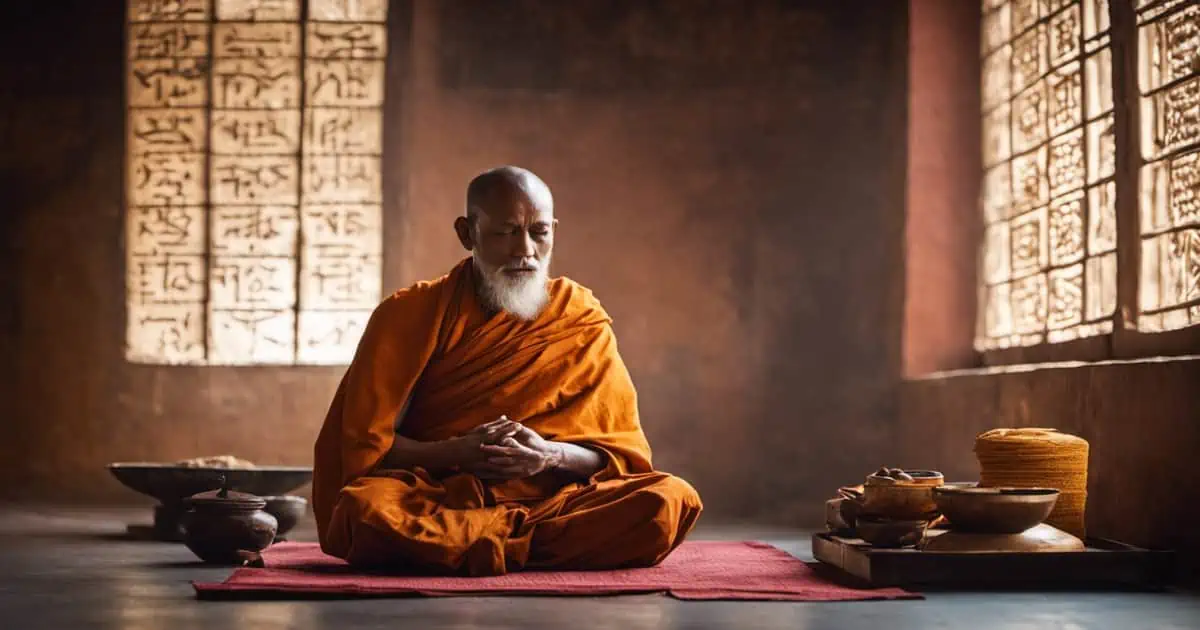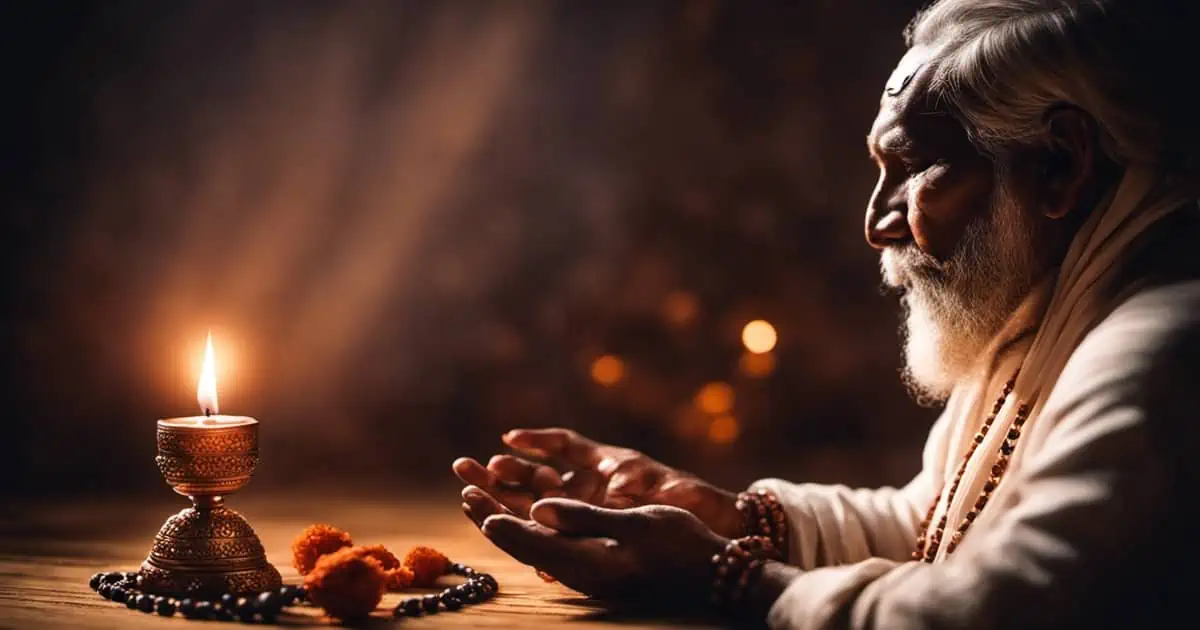Key Takeaway
The Maha Mrityunjaya Mantra is a transformative chant in honor of Lord Shiva that promotes healing, liberation, and enlightenment, embodying the essence of life’s impermanence and the quest for spiritual growth.
The Maha Mrityunjaya Mantra is a powerful verse from the Rigveda and one of the most potent Hindu mantras. Did you know it holds a significant place in Hinduism due to its association with Lord Shiva, also known as Tryambaka?
Interestingly, this mantra is often used in meditation practices and is attributed to the sage Markandeya. I was fascinated to discover that the sacred phrase or mantra has been chanted by devotees seeking liberation (mukshiya) from death (mrityor) since ancient times.
During my research, I came across the fascinating story of Markandeya, a great sage who was saved from certain death by chanting this sacred phrase. This awe-inspiring account left me with a newfound appreciation and reverence for the incredible power of Maha Mrityunjaya Mantra.
This highlights the significance of mantras in meditation. The Maha Mrityunjaya Mantra, commonly known as the Shiva mantra, is a healing meditation, and in this post, we will explore its rich history and profound meaning.
Contents
Interpreting the Maha Mrityunjaya Mantra
After spending years practicing meditation, I came to realize that the most crucial aspect of using mantras in your practice is understanding their meaning. It is essential to comprehend its true essence to reap the full benefits of meditation.
So, let us break down this mantra and explore its hidden meaning, which will help us to achieve a peaceful and calm mind.
Understanding the Sanskrit Words
The mantra chanted in honor of Yama and the universe begins with “Om Tryambakam Yajamahe,” where ‘Tryambakam’ refers to Lord Shiva, and Markandeya often recites it. Shiva, the light of the universe, is visualized as having three eyes – the sun, moon, and fire, reflecting his cosmic mind.
- Om: The universal sound
- Tryambakam: The three-eyed one (Lord Shiva)
- Yajamahe: We worship
This verse implies our reverence for Shiva, who embodies all aspects of reality and life, much like Markandeya’s chant of ‘Om.’
Spiritual Meaning Behind Each Line
Every word in this mantra carries profound spiritual significance. For instance, “Sugandhim Pushtivardhanam” talks about nourishment. In the chant of life, we seek the divine fragrance that enriches our health and well-being, a Markandeya symbolized by the resonating ‘Om.’
Another line, “Urvarukamiva Bandhanan,” uses a cucumber metaphor. Just as a ripe cucumber effortlessly separates from its vine, we, like Markandeya, pray to Shiva for liberation from our mortal life ties, day by day.
Relation to Life, Death, and Liberation
The Maha Mrityunjaya Mantra, often chanted in honor of Shiva, relates to life and death through its emphasis on immortality or ‘moksha.’ Markandeya was known to chant this mantra, often beginning with the powerful syllable ‘Om.’ It encapsulates our human yearning for transcendence beyond mortality.
In essence, the chant of “Om” to Shiva by Markandeya is not just about averting death but embracing an enlightened view of life and death. The practice of Shiva and Markandeya helps us realize that freedom isn’t merely an escape from death but an understanding of life’s impermanence, day by day.
Proper Chanting Techniques of the Mantra
This sacred phrase is traditionally divided into four lines, with each line consisting of eight syllables each:
Om Tryambakam Yajamahe
Sugandhim Pushtivardhanam
Urvarukamiva Bandhanan
Mrityor Mukshiya Maamritat
Correct Pronunciation for Effective Chanting
Chanting this powerful mantra requires accuracy. Each syllable in the Maha Mrityunjaya mantra, a chant dedicated to Shiva and practiced by Markandeya, holds significance, so proper pronunciation during practice is key.
For instance, “Om” initiates the chant dedicated to Shiva, setting a sacred tone for life.
The phrase “tryambakam yajamahe sugandhim pushtivardhanam,” follows next. It’s a chant, a plea to the three-eyed Lord Shiva from Rigveda, that permeates life.
“Urvarukamiva bandhanan mrityor mukshiya maamritat” concludes the chant. This line, a chant dedicated to Shiva, seeks salvation from death and an embrace of immortality.
Exploring Variations of the Mantra
Here we are, diving into the sea of variations in the maha mrityunjaya mantra, a sacred chant often associated with Shiva and the resonating sound of Om.
Different Versions Across Scriptures
The maha mrityunjaya mantra, associated with Shiva, has been sung and chanted by sages across time. But did you know it’s not always the same verse in Shiva’s context? The scriptures show different versions of this powerful phrase.
- For instance, the Rigveda gives us one version.
- Another comes from the Taittiriya Samhita.
Each repetition of Shiva carries a unique vibration that works with the universe’s nature.
Regional Variations Due to Cultural Influences
But it’s not just about what book you’re reading from, even if it’s about Shiva. Where you’re from also plays a part!
- In some parts of India, they add an extra word or two, often related to Shiva.
- In others, they might change a word for something that fits their Shiva dialect better.
These regional repetitions infuse local culture into this universal healing mantra, and it adds even more value and beauty to it.
Impact on Interpretation and Usage
So, what does all this variation mean for how we use and understand the mantra?
Well, each version can bring about different feelings of inner peace. Some may focus more on release from Yama, while others might emphasize health or happiness. It’s all about personal faith and growth.
In essence, every variation tells its own story about our infinite journey toward salvation and inner peace in this universe. And no matter which version you chant, remember that its power lies not just in the words but also in your faith and intention.

Benefits of Chanting Maha Mrityunjaya Mantra
I have been fortunate to experience the incredible power of the Maha Mrityunjaya Mantra. Its use has brought me immense physical and spiritual benefits, and I am eager to share these advantages together with you.
Physical Perks: Stress Relief and Focus
Chanting the mantra can help you chill out during stressful days. It’s like a natural stress-buster, no kidding!
- Research shows it lowers blood pressure.
- It also improves concentration, according to studies.
So, next time you’re feeling stressed or can’t focus on work or your studies, try chanting the mantra.
Spiritual Gains: Inner Peace and Enlightenment
This isn’t just about your body. Your spirit gets a boost, too.
- You’ll feel more at peace with yourself. There is a sense of tranquility.
- I can even say I’ve achieved enlightenment through regular chanting in order to rediscover myself.
That’s some heavy stuff right there! I hope it motivates you to give it a try.
Healing Power According to Ancient Texts
There’s more to this mantra than meets the eye. Ancient texts talk about its healing properties.
- The Rig Veda mentions its potential to cure diseases.
- Other texts suggest it could even extend the life span.
Now that’s something worth giving a shot, don’t you think?
When & How to Chant Maha Mrityunjaya Mantra
The Maha Mrityunjaya mantra is a spiritual practice that has been used for centuries to heal, protect, and receive divine guidance. Its simple yet profound chant is accessible to everyone, regardless of their spiritual beliefs. But when and how should you chant it?
Start the Day with the Maha Mrityunjaya Mantra
Starting the day by chanting the Mahamrityunjay Mantra can bring positive energy into your life, relieve stress, and bring good luck into your workday. According to the Shiv Purana, chanting this mantra 108 times daily can have profound effects on your life.
Ultimately, the benefits of this mantra can be experienced at any time of the day, so take a moment to breathe deeply and recite the Mahamrityunjay Mantra whenever you need to recharge and stay focused on your goals.
The Power of the Mantra
The power of the mantra lies in its repetition, which can be accomplished in one sitting or over several sessions. Chanting the mantra silently allows for a deeper, more focused practice, but it can also be chanted aloud if preferred.
Remember that with each repetition, you are bringing yourself closer to a state of inner peace and clarity. Keep going, and let the power of the mantra guide you on your journey.
In order to receive the most benefit from the Maha Mrityunjaya mantra, it is best to chant it at least once a day, preferably in the morning or before noon.
The most auspicious time to practice the chant is just before sunrise, during the brahma muhurta, which is considered a particularly conducive time for spiritual practices.
Prepare for Chanting
Chanting the Maha Mrityunjaya mantra is a powerful spiritual practice that requires one’s full attention and focus.
To begin this practice, it is essential to find a quiet and peaceful place where you can sit comfortably without any distractions.
You can use prayer beads, called mala, to count repetitions and stay focused. This mala consists of 108 beads, which is an ideal amount to recite the maha mrityunjaya mantra 108 times.
Another advice from me is to light a candle or some incense to create a calming atmosphere. Now close your eyes and take a few deep breaths to calm your mind and center yourself. As you inhale, feel the air filling your lungs; as you exhale, allow any tension or stress to leave your body.

Chakra & Luck Votive Candles Scent Pack of Aromatherapy Candle Set Eucalyptus Candle Lavender Candle...
See latest priceWhen you are ready to begin chanting the mantra, start reciting it with a calm and steady voice. It is important to pay attention to each word and focus your mind on the intention of your recitation.
The Mantra’s Overall Significance
Through an exploration of the Maha Mrityunjaya Mantra, its interpretation, chanting techniques, variations, and benefits have been unveiled.
This ancient Sanskrit chant holds a profound spiritual significance that can be harnessed through proper practice. With its potential to bring about peace, health, and longevity, it is no wonder why this mantra continues to resonate with individuals worldwide.
Explore the profound world of Maha Mrityunjaya Mantra and make it a part of your daily meditation practice. Remember to honor and appreciate the cultural heritage of these ancient traditions, which adds even more significance to their transformative power.
Frequently Asked Questions
What does the Maha Mrityunjaya Mantra mean?
The Maha Mrityunjaya Mantra is a powerful Hindu invocation directed to Lord Shiva. It seeks divine protection against great death and disease while asking for health, longevity, strength, and ultimate salvation.
How should I chant the Maha Mrityunjaya Mantra?
Chanting should be done mindfully with correct pronunciation of the syllables through your yoga practice. You may follow along with an MP3 guide or learn from a qualified teacher. But what is most important is that it must come from your heart so you can accept its healing energy.
Are there variations of this mantra?
Yes, there are several versions of this mantra based on different traditions within Hinduism. Each version carries similar themes but may vary slightly in wording or structure. Ultimately, in the end, all of them have the same role in helping defeat the fear you face and act from a place of self-awareness.
What are some benefits of chanting this mantra?
Regularly chanting this mantra is believed to promote physical health and vitality, mental peace and clarity, emotional stability, and spiritual growth.
Where can I find an MP3 download guide for this mantra?
There are numerous online platforms offering MP3 downloads for the Maha Mrityunjaya Mantra. Ensure you choose a reliable source for high-quality audio.


